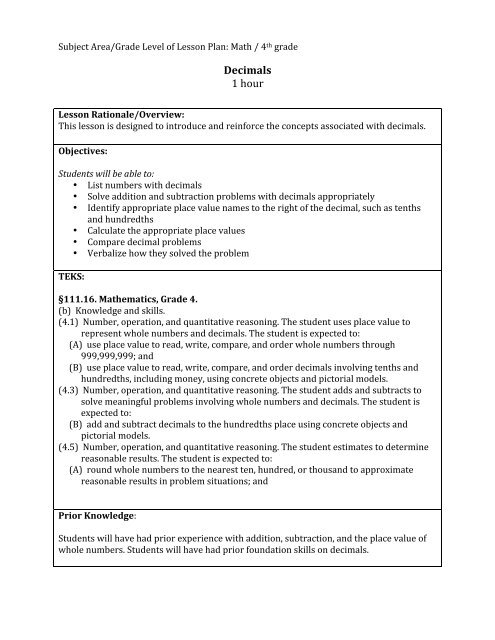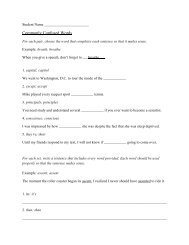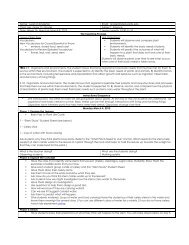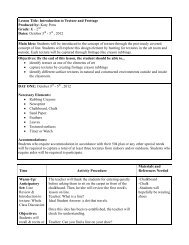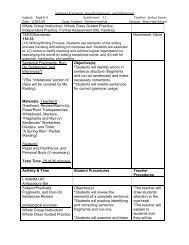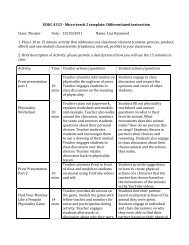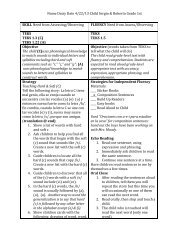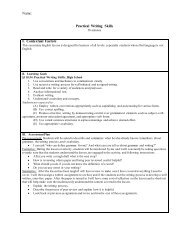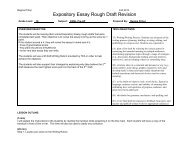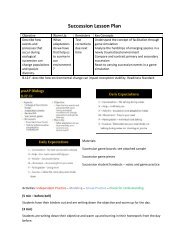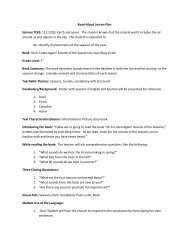Fourth Grade Math Lesson Plan on Decimals - St. Edwards University
Fourth Grade Math Lesson Plan on Decimals - St. Edwards University
Fourth Grade Math Lesson Plan on Decimals - St. Edwards University
You also want an ePaper? Increase the reach of your titles
YUMPU automatically turns print PDFs into web optimized ePapers that Google loves.
Subject Area/<str<strong>on</strong>g>Grade</str<strong>on</strong>g> Level of <str<strong>on</strong>g>Less<strong>on</strong></str<strong>on</strong>g> <str<strong>on</strong>g>Plan</str<strong>on</strong>g>: <str<strong>on</strong>g>Math</str<strong>on</strong>g> / 4 th grade<strong>Decimals</strong>1 hour<str<strong>on</strong>g>Less<strong>on</strong></str<strong>on</strong>g> Rati<strong>on</strong>ale/Overview:This less<strong>on</strong> is designed to introduce and reinforce the c<strong>on</strong>cepts associated with decimals.Objectives:<strong>St</strong>udents will be able to:• List numbers with decimals• Solve additi<strong>on</strong> and subtracti<strong>on</strong> problems with decimals appropriately• Identify appropriate place value names to the right of the decimal, such as tenthsand hundredths• Calculate the appropriate place values• Compare decimal problems• Verbalize how they solved the problemTEKS:§111.16. <str<strong>on</strong>g>Math</str<strong>on</strong>g>ematics, <str<strong>on</strong>g>Grade</str<strong>on</strong>g> 4.(b) Knowledge and skills.(4.1) Number, operati<strong>on</strong>, and quantitative reas<strong>on</strong>ing. The student uses place value torepresent whole numbers and decimals. The student is expected to:(A) use place value to read, write, compare, and order whole numbers through999,999,999; and(B) use place value to read, write, compare, and order decimals involving tenths andhundredths, including m<strong>on</strong>ey, using c<strong>on</strong>crete objects and pictorial models.(4.3) Number, operati<strong>on</strong>, and quantitative reas<strong>on</strong>ing. The student adds and subtracts tosolve meaningful problems involving whole numbers and decimals. The student isexpected to:(B) add and subtract decimals to the hundredths place using c<strong>on</strong>crete objects andpictorial models.(4.5) Number, operati<strong>on</strong>, and quantitative reas<strong>on</strong>ing. The student estimates to determinereas<strong>on</strong>able results. The student is expected to:(A) round whole numbers to the nearest ten, hundred, or thousand to approximatereas<strong>on</strong>able results in problem situati<strong>on</strong>s; andPrior Knowledge:<strong>St</strong>udents will have had prior experience with additi<strong>on</strong>, subtracti<strong>on</strong>, and the place value ofwhole numbers. <strong>St</strong>udents will have had prior foundati<strong>on</strong> skills <strong>on</strong> decimals.
Subject Area/<str<strong>on</strong>g>Grade</str<strong>on</strong>g> Level of <str<strong>on</strong>g>Less<strong>on</strong></str<strong>on</strong>g> <str<strong>on</strong>g>Plan</str<strong>on</strong>g>: <str<strong>on</strong>g>Math</str<strong>on</strong>g> / 4 th gradeMaterials / resources / equipment needed:Teacher:• White board and markers• Book orders• Worksheet/handout to list the book and the price• Paper• Counters<strong>St</strong>udent:• Pencil• Each student will be provided a book order and a worksheet to record the booksthey will “purchase”• Scratch paper• Counters available if neededDaily Agenda:(What I will write <strong>on</strong> the board so that the students’ know what is going to happenduring this less<strong>on</strong> plan).1. Objective and standard met: Adding and Subtracting <strong>Decimals</strong>2. What they should be able to do to show their understanding by the end of the less<strong>on</strong>:Verbalize to the class how to solve additi<strong>on</strong> and subtracti<strong>on</strong> problems with decimals.Explain how it relates to real life scenarios.3. Major activities for less<strong>on</strong>: Solve decimal problems, apply them to real life scenarios4. Homework or next time: Find another real life scenario where you add or subtractdecimals.Activities:Introducti<strong>on</strong>:Part 1: (5 minutes)• Ask students what they know about decimals and the place values after the decimal• Have the students write down their thoughts and what they know about decimals,or have the students talk am<strong>on</strong>gst the other students sitting around them aboutdecimals• Call <strong>on</strong> students to give general ideas of decimals• Recap the overall c<strong>on</strong>cept of decimals and write them <strong>on</strong> the boardPart 2: (5 minutes)• Give students the book orders• Allow the students two or three minutes to look through the book orders. Let themget all their excitement and curiosity out with each other.• Bring the class together, and ask the students if they can point out a number with adecimal in the book order.• Discuss m<strong>on</strong>ey, decimals, and place values.Activity 1: (10 minutes)• Give students directi<strong>on</strong>s: Find two books, any two books in the book order, and addthem together.
Subject Area/<str<strong>on</strong>g>Grade</str<strong>on</strong>g> Level of <str<strong>on</strong>g>Less<strong>on</strong></str<strong>on</strong>g> <str<strong>on</strong>g>Plan</str<strong>on</strong>g>: <str<strong>on</strong>g>Math</str<strong>on</strong>g> / 4 th grade• Walk around the room to make sure every<strong>on</strong>e is writing the decimals correctly. Thedecimals should be in line with <strong>on</strong>e another.• In groups, have the students compare and c<strong>on</strong>trast the sum of the two numbers andthe price of the books added together.• Bring the class together and discuss the results.Activity 2: (30 minutes)• Reflect <strong>on</strong> what their first activity was, and then give the students directi<strong>on</strong>s for thesec<strong>on</strong>d activity.• Directi<strong>on</strong>s: One of your family member’s birthdays is coming up. You need to getthem a gift and you have <strong>on</strong>e hundred dollars to spend <strong>on</strong> book orders. Calculate thecost of the books you want to get for them. The price of each book ranges. The totalnumber of books you will buy could differ from the number of books the pers<strong>on</strong>next to you buys. Be careful. You cannot spend over <strong>on</strong>e hundred dollars. Onceyou’ve added together the cost of the books that you want buy for them, you willhave a total cost for all the books. Subtract the total cost of the books from thehundred dollars you have to figure out how much left over m<strong>on</strong>ey you will haveafter you make the purchase.• Ask a student to repeat the directi<strong>on</strong>s to make sure they understand.• Let them get started <strong>on</strong> their activity.• Walk around and ask the students what books they are c<strong>on</strong>sidering and the prices ofthe book. Make sure the students are adding the books together appropriately.C<strong>on</strong>clusi<strong>on</strong>: (10 minutes)• Bring the class together as the students finish their activity.• In groups, have students compare and c<strong>on</strong>trast the total cost of their books and howmany books they could buy less than <strong>on</strong>e hundred dollars.• Let the groups share what they discovered.• Have a class discussi<strong>on</strong> about the overall activities.• Questi<strong>on</strong>s to lead discussi<strong>on</strong> could be:o What is something you learned today?o What is something new you learned about fracti<strong>on</strong>s?o What was your favorite part of today’s less<strong>on</strong>?o What was something you didn’t like about today’s less<strong>on</strong>?o What part did you find easy?o What part did you find hard?o Are there any methods or tools that you used to make the process easier?(For example, rounding to the nearest whole number to approximate howmuch m<strong>on</strong>ey has been spent.)o How can you apply a problem like this to real life scenarios?Homework:Have the students add the prices of six items in a grocery store. If a student does not haveaccess to a grocery store, then give them a handout with a list of grocery store like itemswith their prices.
Subject Area/<str<strong>on</strong>g>Grade</str<strong>on</strong>g> Level of <str<strong>on</strong>g>Less<strong>on</strong></str<strong>on</strong>g> <str<strong>on</strong>g>Plan</str<strong>on</strong>g>: <str<strong>on</strong>g>Math</str<strong>on</strong>g> / 4 th gradeAssessment:Formative:During the activity the students will be asked:• What is a number with a decimal?• What is the place value of a number?• How do you line up numbers with decimals in an additi<strong>on</strong> or subtracti<strong>on</strong> problem?• What does the number $ . ___ round to?Summative:<strong>St</strong>udents will be tested at the end of the unit through a test provided by the school.


